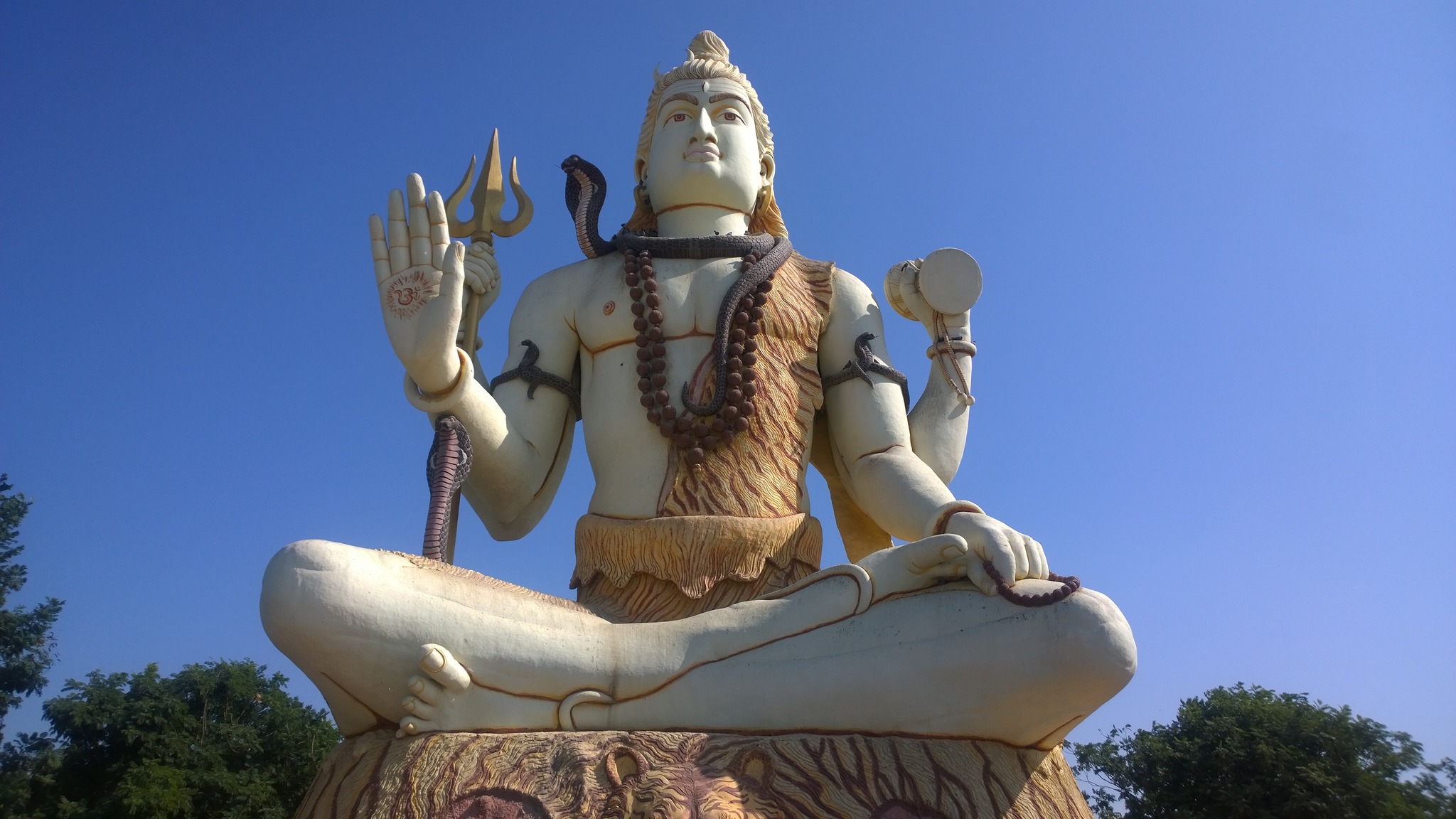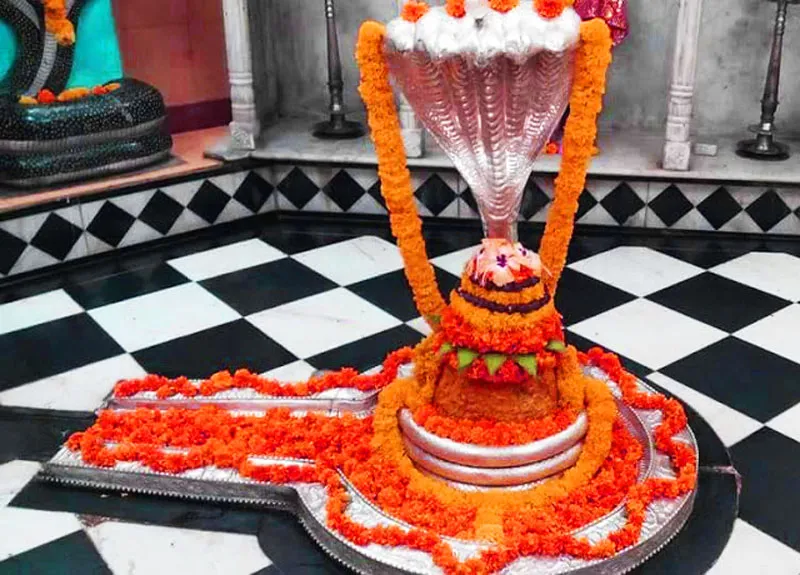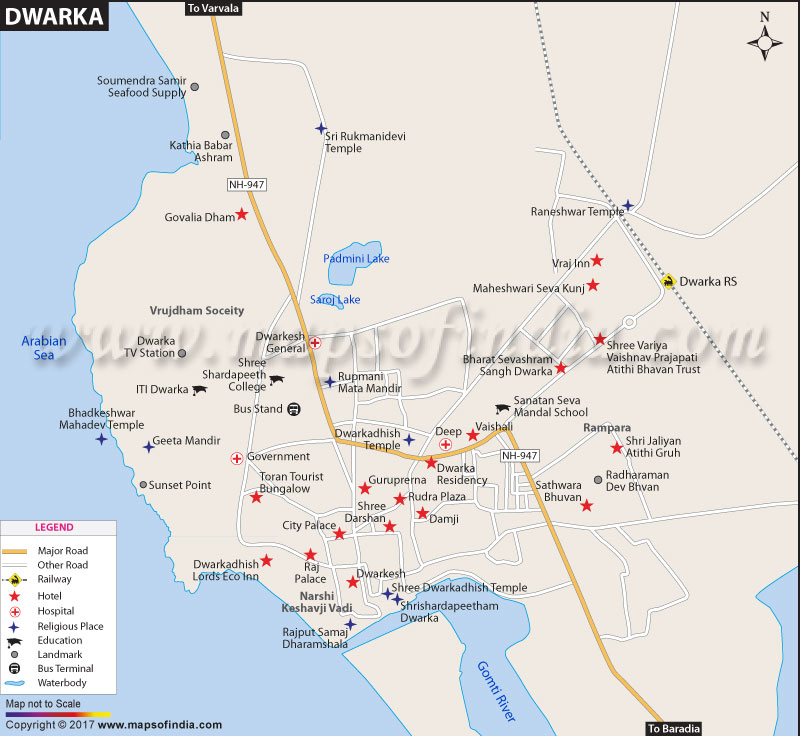
A 25-meter tall statue of Lord Shiva at Nageshwar Jyotirlinga near Dwarka, symbolizing the temple’s spiritual and cultural significance
Nageshwar Jyotirlinga Dwarka: Complete Tourist Guide and Travel Information
Nageshwar Jyotirlinga stands as one of India’s twelve most sacred Jyotirlingas, located approximately 18 kilometers from Dwarka in Gujarat. This ancient temple dedicated to Lord Shiva attracts thousands of devotees and tourists annually, offering a unique spiritual experience in the historic land of Darukavanam.
Temple Overview and Significance
Nageshwar Jyotirlinga, also known as Nagnath Temple, holds the distinction of being one of the twelve Jyotirlingas mentioned in the Shiva Purana. The temple is uniquely positioned between Gomati Dwarka and Beyt Dwarka Island on the Saurashtra coast. The name “Nageshwar” translates to “Lord of Serpents,” symbolizing Lord Shiva’s power to protect devotees from all forms of poison, particularly snake venom.
The temple’s most striking feature is the magnificent 25-meter tall statue of Lord Shiva in a seated meditation posture. This impressive sculpture, visible from kilometers away, serves as a beacon for pilgrims approaching the sacred site. The statue stands majestically in landscaped gardens with a surrounding pond, creating a serene atmosphere for contemplation and worship.
Religious and Mythological History
The Legend of Darukavanam
According to the Shiva Purana, the temple is situated in the ancient forest of Darukavanam. The most popular legend tells of a demon named Daruka who, along with his wife Daruki, terrorized the region and imprisoned devotees, including a great Shiva devotee named Supriya. Despite being captive, Supriya continued chanting “Om Namah Shivaya,” which eventually invoked Lord Shiva’s presence. Shiva appeared, vanquished the demons, and chose to reside permanently at this location as a Jyotirlinga.
Connection with Lord Krishna
The temple holds special significance as it is believed that Lord Krishna performed Rudrabhisheka here and that Adi Shankaracharya established the foundations of his Western Math at Kalika Peetha in this sacred location.
Temple Architecture and Sacred Features

Nageshwar Jyotirlinga decorated with marigold flowers and serpent hood in its temple sanctum near Dwarka
The Nageshwar Jyotirlinga is housed in an underground sanctum, making it unique among Jyotirlingas. The sacred Shivling is carved from Dwarka Shila stone and features small chakras, taking the distinctive shape of a Tri-Mukhi Rudraksha. Notably, the Shivling faces south while the temple faces east, a positioning that has its own mythological significance related to the devotee Saint Namdev.
Temple Timings and Darshan Information
| Schedule | Timing |
|---|---|
| Morning Darshan | 6:00 AM – 12:30 PM |
| Afternoon Break | 12:30 PM – 5:00 PM |
| Evening Darshan | 5:00 PM – 9:00 PM |
| Aarti Timings | 6:45 PM – 7:15 PM |
Special Timings:
- During Mahashivratri: 5:00 AM – 9:30 PM (continuous)
- Shravan month: Regular timings maintained
Puja Services and Costs
| Service | Cost | Details |
|---|---|---|
| General Darshan | Free | Basic temple entry |
| Special Darshan | ₹200 (for 2 persons) | Priority access |
| Rudrabhishek | ₹300-500 | Sacred water ceremony |
| Archana Puja Thali | ₹250 | Complete worship set |
| Puja Samagri | ₹200 | Available at temple |
Important Notes:
- Men must remove shirts during Abhishek ceremonies
- Online booking not available; purchase tickets at counter
- Devotees can touch the Shivling during Abhishek
How to Reach Nageshwar Jyotirlinga
By Air
- Jamnagar Airport: 137 km away with connecting taxi services (₹2,000 approximately)
- Porbandar Airport: 107 km away
By Train
- Dwarka Railway Station: 18 km away, well-connected to major Indian cities
- Regular trains from Mumbai, Delhi, Ahmedabad, and other major cities
By Road from Dwarka
- Distance: 15-18 km (conflicting sources, approximately 17 km)
- Travel Time: 30-45 minutes
- Taxi Cost: ₹1,200-3,175 for round trip
Local Transportation Options
Bus Services:
- Regular Nagarpalika (municipal) buses from Dwarka market
- Private bus operators: Sudama Travels, Pushpak Travels, Madhuram Travels
- Ticket Cost: ₹120-300 depending on bus type
- Frequency: 6-9 buses daily
Auto-Rickshaws:
- Available but may charge higher rates for tourists
- Local advice suggests using municipal buses for better rates
Accommodation Options
Near Temple
Limited accommodation directly near Nageshwar temple, with most visitors staying in Dwarka.
Dwarka Accommodation
Government Guest Houses:
- Circuit House: 13 rooms with dining
- DDS Dwarkadhish Athithi Gruh: 16 rooms + dormitory
- Gayatri Athithi Gruh: 9 rooms
Hotels:
- Price range: ₹1,280-4,909 per night
- Popular options: Hawthorn Suites by Wyndham, VITS Devbhumi
- Budget accommodations from ₹800 per night
Festivals and Special Occasions
Major Festivals
Mahashivratri (February-March):
- Most important celebration with night-long vigils
- Special pujas and elaborate decorations
- Massive devotee gatherings from across India
Shravan Month (July-August):
- Entire month dedicated to special rituals
- Daily Jalabhishek and special offerings
- Heavy footfall throughout the month
Nag Panchami:
- Special significance due to temple’s association with serpent worship
- Unique rituals involving snake deity worship
Nearby Attractions and Activities

Dwarka city map showing key landmarks, roads, and tourist spots including temples, transport hubs, and accommodation
Gopi Talav (20 km from Dwarka)
A sacred lake with mythological significance where Lord Krishna’s gopis are believed to have offered their lives. The lake features:
- Boat rides and water activities
- Adventure sports: paintball, wall climbing, zip lines
- Fine yellow soil (Gopi Chandan) with healing properties
- Timings: 6:00 AM – 6:00 PM
Beyt Dwarka
Ancient island accessible by boat from Dwarka, connected to Krishna legends.
Other Temples in Circuit
- Dwarkadhish Temple (main Krishna temple)
- Rukmini Devi Temple
- Bhadkeshwar Mahadev Temple (sunset views)
Local Information and Tips
Best Time to Visit
- Optimal Period: October to March for pleasant weather
- Summer: April-June can be extremely hot (up to 45°C)
- Monsoon: June-September with heavy rainfall affecting travel
Photography Guidelines
- Photography prohibited inside the main sanctum
- Allowed areas: Temple exterior, gardens, Shiva statue
- Statue area perfect for tourist photographs
Shopping and Souvenirs
Popular Items:
- Chakrashila: Unique coral stones with wheel-like formations
- Gopi Chandan: Sacred yellow soil from Gopi Talav
- Lord Shiva idols and religious artifacts
- Bandhani textiles and traditional Gujarati handicrafts
Shopping Areas:
- Local shops around temple premises
- Dwarka main market area
- Souvenir stalls near major attractions
Dress Code and Guidelines
- Men: Shirt and trouser, dhoti, or traditional Indian wear
- Women: Saree, half-saree, or modest traditional clothing
- Special Requirements: Men must remove upper clothing during Abhishek
Food and Dining
Near Temple:
- Limited dining options directly at temple
- Basic vegetarian meals available
In Dwarka:
- Traditional Gujarati thalis (₹200-400 per person)
- Popular restaurants: Chappan Bhog, Shree Dwarkesh Bhojanalay
- Street food and local specialties available
Practical Travel Tips
Duration of Visit
- Temple Visit: 1-2 hours including darshan and prayers
- Combined Tour: 6-8 hours including Gopi Talav and Beyt Dwarka
Crowd Management
- Weekdays: 20-30 minutes darshan time
- Weekends: 40-50 minutes or longer
- Festival Periods: Significantly longer waiting times
- Best Times: Early morning (6:00 AM) for peaceful darshan
Safety and Precautions
- Carry sufficient water, especially during summer
- Wear comfortable walking shoes
- Keep valuables secure in crowds
- Follow temple dress codes strictly
- Respect photography restrictions
Contact Information
- Temple Contact: 86688 56667, 89836 57221
- Local Tourism: Available through Gujarat Tourism offices
Special Features Making Nageshwar Unique
- Underground Sanctum: One of the few Jyotirlingas housed underground
- Tri-Mukhi Rudraksha Shape: Distinctive three-faced form of the Shivling
- South-Facing Linga: Unique orientation with mythological significance
- Touching Allowed: Devotees can physically touch the Jyotirlinga during Abhishek
- Poison Protection: Believed to protect from all forms of poison and negativity
The Nageshwar Jyotirlinga offers a profound spiritual experience combining ancient mythology, architectural beauty, and devotional practices. Whether visiting as a devout pilgrim or curious tourist, this sacred site provides insights into India’s rich religious heritage while offering modern facilities and accessibility for contemporary travelers. The temple’s unique features, combined with its proximity to other significant sites in Dwarka, make it an essential destination for anyone exploring Gujarat’s spiritual landscape.